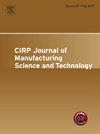刀具磨削形状误差自动补偿体系
IF 5.4
2区 工程技术
Q2 ENGINEERING, MANUFACTURING
CIRP Journal of Manufacturing Science and Technology
Pub Date : 2025-02-14
DOI:10.1016/j.cirpj.2025.02.001
引用次数: 0
摘要
针对单个圆柱刀具的刀具磨削操作的工艺规划需要专业知识以及调整测试,以便根据质量要求进行生产性制造。圆柱毛坯的静态偏转,特别是在钻具形状误差和芯径偏差的情况下,随工件轴向位置的变化而变化。本文提出了一种利用nc仿真技术实现工艺规划中形状误差自动补偿的体系结构。在快速预测弹性工件挠度的基础上,通过优化工艺参数和根据弯曲线调整刀具轨迹来修改初始NC代码。数据反馈的概念确保了自学习效果并使模型能够自适应。结果表明,当晶粒尺寸D9和D54之间存在未知砂轮规格时,预测结果可以进行调整。在实验研究中,形状误差可以减少在88%到99%的范围内,生产率提高47%。本文章由计算机程序翻译,如有差异,请以英文原文为准。
Architecture for autonomous shape error compensation in tool grinding
Process planning of tool grinding operations for individual cylindrical tools requires expert knowledge as well as adjustment tests in order to enable productive manufacturing according to the quality requirements. Static deflections of the cylindrical blank lead especially in the case of drilling tools to shape errors and core diameter deviations that vary with the axial workpiece position. This paper presents an architecture to compensate for shape errors autonomously in process planning by using a technological NC-Simulation. Based on a fast prediction of the elastic workpiece deflection, the initial NC code is modified by optimizing process parameters and adapting the tool path according to the bending line. A concept for data feedback ensures self-learning effects and enables model adaption. It is shown how the prediction can be adjusted for unknown grinding wheel specifications between the grain sizes D9 and D54. In experimental investigations, the shape error could be reduced in a range of 88 % to 99 % with a productivity increase of 47 %.
求助全文
通过发布文献求助,成功后即可免费获取论文全文。
去求助
来源期刊

CIRP Journal of Manufacturing Science and Technology
Engineering-Industrial and Manufacturing Engineering
CiteScore
9.10
自引率
6.20%
发文量
166
审稿时长
63 days
期刊介绍:
The CIRP Journal of Manufacturing Science and Technology (CIRP-JMST) publishes fundamental papers on manufacturing processes, production equipment and automation, product design, manufacturing systems and production organisations up to the level of the production networks, including all the related technical, human and economic factors. Preference is given to contributions describing research results whose feasibility has been demonstrated either in a laboratory or in the industrial praxis. Case studies and review papers on specific issues in manufacturing science and technology are equally encouraged.
 求助内容:
求助内容: 应助结果提醒方式:
应助结果提醒方式:


